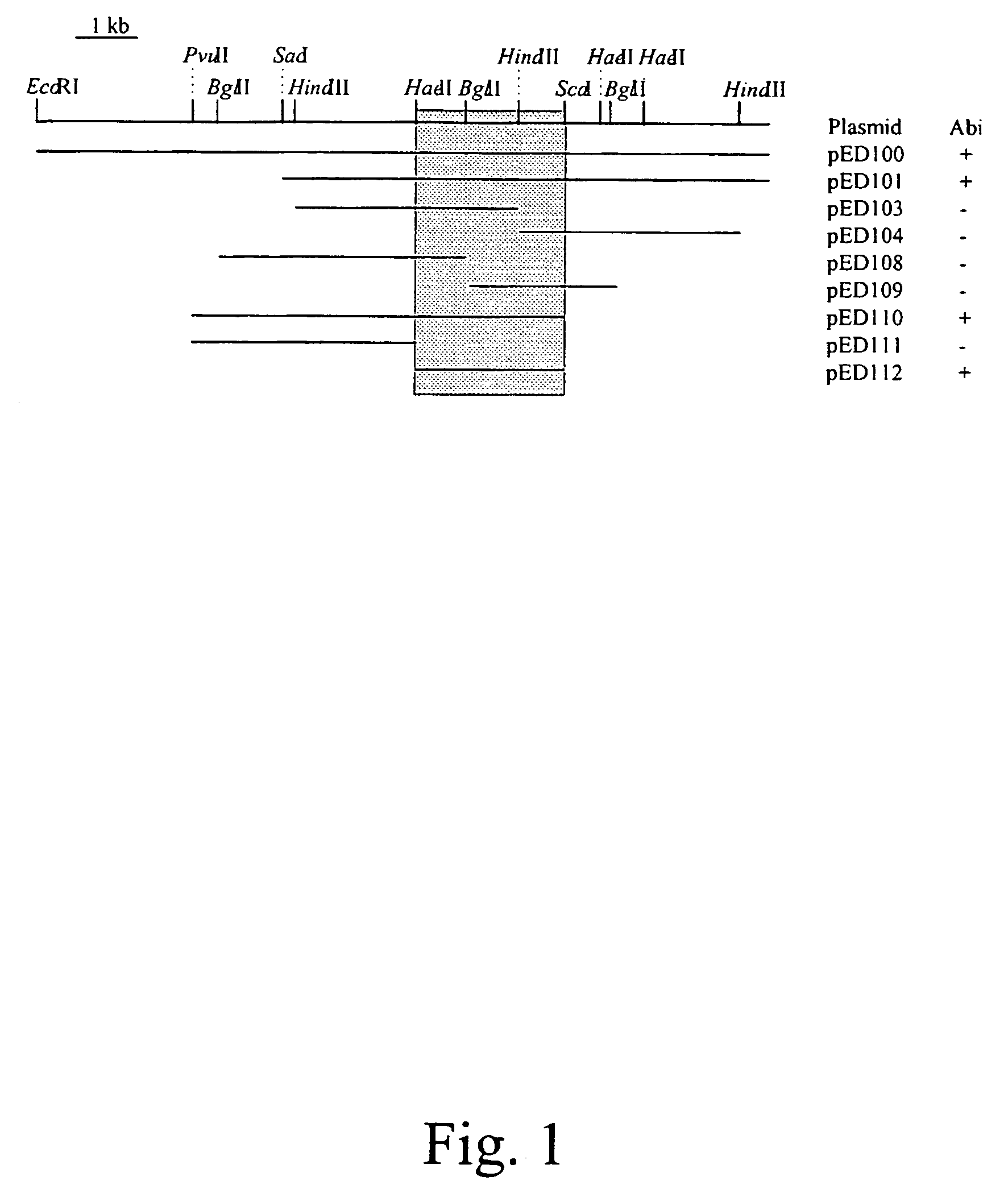Fragment of L. lactis plasmid conferring antiphage activity and uses thereof
a technology of lactis plasmid and fragment, which is applied in the field of dna fragment encoding abitype proteins, can solve the problems of limited exploitation of many anti-phage systems, substantial economic losses in the dairy industry, and rare use of natural evolutionary processes
- Summary
- Abstract
- Description
- Claims
- Application Information
AI Technical Summary
Benefits of technology
Problems solved by technology
Method used
Image
Examples
example i
Activity of AbiTi and AbiTii
[0052]
TABLE 1Efficiency of plaquing (EOP) of phages belonging to thethree most common phage species in the dairy industry onstrains containing AbiT936 speciesP335 speciesc2 speciesphageEOPphageEOPphageEOPp29.5 ± 3.9 × 10−6ul362.6 ± 1.5 × 10−7c21.0p2k1.4 ± 0.6 × 10−6Q301.6 ± 0.4 × 10−7ml31.0sk12.1 ± 1.4 × 10−5phi311.9 ± 0.8 × 10−7eb11.0jj501.9 ± 0.8 × 10−5phi504.5 ± 3.4 × 10−6
[0053]Anti-viral systems in L. lactis are currently classified in four groups based on their general mode of action: adsorption blocking, DNA ejection blocking, restriction / modification (R / M), and abortive infection systems. Phages adsorption is not inhibited by the presence of the 2227-bp DNA fragment (Table 2). Phage DNA replication is observed in cells carrying this anti-phage system indicating that the phage DNA is ejected within the cells despite the presence of the 2227-bp DNA fragment. Phages isolated in presence of the anti-phage mechanism are permanently insensitive to it ind...
example ii
Abortive Phage Infection Mechanism AbiT from Lactococcus lactis
Materials and Methods
Bacterial Strains, Plasmids, and Media
[0056]Strains and plasmids used in this study are listed in Table 3. E. coli was grown at 37° C. in LB medium and L. lactis was grown at 30° C. in M17 (Quélab) supplemented with 0.5% glucose (GM17) or, in the case of W51, with 0.5% lactose (LM17). When needed, antibiotics were added to the media at the following concentrations: 50 μg of ampicillin per ml or 20 μg of chloramphenicol per ml for E. coli and 5 μg of chloramphenicol or erythromycin per ml for L. lactis.
Bacteriophage Propagation and Microbiological Assays
[0057]Bacteriophages used in this study are listed in Table 3. The efficiency of plaquing (EOP) was calculated by dividing the phage titer on the tested strain by the titer on the sensitive control strain. Adsorption assays were conducted as described by Sanders and Klaenhammer (1980, Appl. Environ. Microbiol. 40:500–506) and cell survival was assaye...
PUM
| Property | Measurement | Unit |
|---|---|---|
| Volume | aaaaa | aaaaa |
| Volume | aaaaa | aaaaa |
| Size | aaaaa | aaaaa |
Abstract
Description
Claims
Application Information
 Login to View More
Login to View More - R&D
- Intellectual Property
- Life Sciences
- Materials
- Tech Scout
- Unparalleled Data Quality
- Higher Quality Content
- 60% Fewer Hallucinations
Browse by: Latest US Patents, China's latest patents, Technical Efficacy Thesaurus, Application Domain, Technology Topic, Popular Technical Reports.
© 2025 PatSnap. All rights reserved.Legal|Privacy policy|Modern Slavery Act Transparency Statement|Sitemap|About US| Contact US: help@patsnap.com



